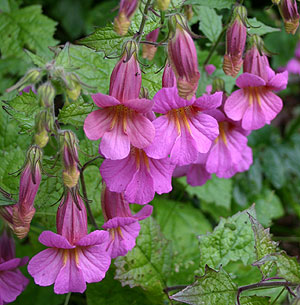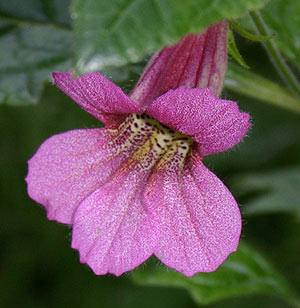Rehmannia elata
CHINESE FOXGLOVE, BEVERLY BELLS
Family: Scrophulariaceae
Pronounced: reh-MAHN-ee-ah ay-LAH-ta
Quick Jumps
Growing Guide
Rainy Side Notes
GROWING GUIDE

Origin:
China.
Plant Group:
Perennials.
Hardiness:
Sunset zones: — according to Sunset, zone 6 is very marginal, 7-10, 12-24.
USDA zones: ?-10.
My references show conflicting zones. This perennial grows in the maritime Pacific Northwest yet Sunset reports say they are not hardy in Sunset zones: 4 and 5. I hear reports R. elata is hardy to USDA zone 5 in New York, but my references say anywhere between 7-10 to 8-10 to 9-10. I say try them in your garden in a protected area; from my experience they are hardy in our maritime climate.
Mature size:
Height: 3 feet (90 cm).
Width: 20 inches (50 cm).
Flowering period:
Spring through fall, during cooler temperatures the plant will flower more than during hot weather.
Flowering attributes:
Foxglove-like tubular pinkish-purple flowers with yellow throats, spotted with red, on terminal racemes.
Leaf attributes:
Oblong with lobed or toothed hairy, green (sometimes red-tinged) leaves arranged in rosettes.
Growth habit:
Rosette forming.
Light:
Full sun to partial shade.
Soil:
Rich, fertile, well-drained soil.
Feeding:
Side dress with compost and a complete organic fertilizer in spring.
Propagation Methods:
Sow seed at 55-61ºF (13-16ºC); germination in about two weeks. | Root cuttings in late fall. | Softwood cuttings before flowering in spring. | Dig up runners in spring and transplant to new location.
Rainy Side Notes

Rehmannia is named after Joseph Rehmann (1799-1831) a physician in Petrograd, Russia. Elata means tall. The flowers of this plant look like a foxglove on steroids. I believe this is a great alternative plant to grow in the Pacific Northwest, instead of its weedy cousin — Digitalis purpurea (foxglove). Not only does it bloom longer than digitalis it has a showier flower. R. elata takes advantage of our mild climate and blooms over a long period. Politely it sends out underground runners to form colonies and is reportedly deer and rabbit resistant. This may not be hardy in the colder areas of the maritime Pacific Northwest; however, if given the right conditions it may continue to overwinter in your garden.
Give Rehmannia a good mulch of leaves during winter to protect it from winter wet. Plant it out where it is protected from winter winds in well-drained soil. During our drought season, be sure to give supplemental water to this plant. It makes an excellent cut flower.
Photographed in author's garden.

Gardening for the Homebrewer: Grow and Process Plants for Making Beer, Wine, Gruit, Cider, Perry, and More
By co-authors Debbie Teashon (Rainy Side Gardeners) and Wendy Tweton
Copyright Notice | Home | Search | Perennials

